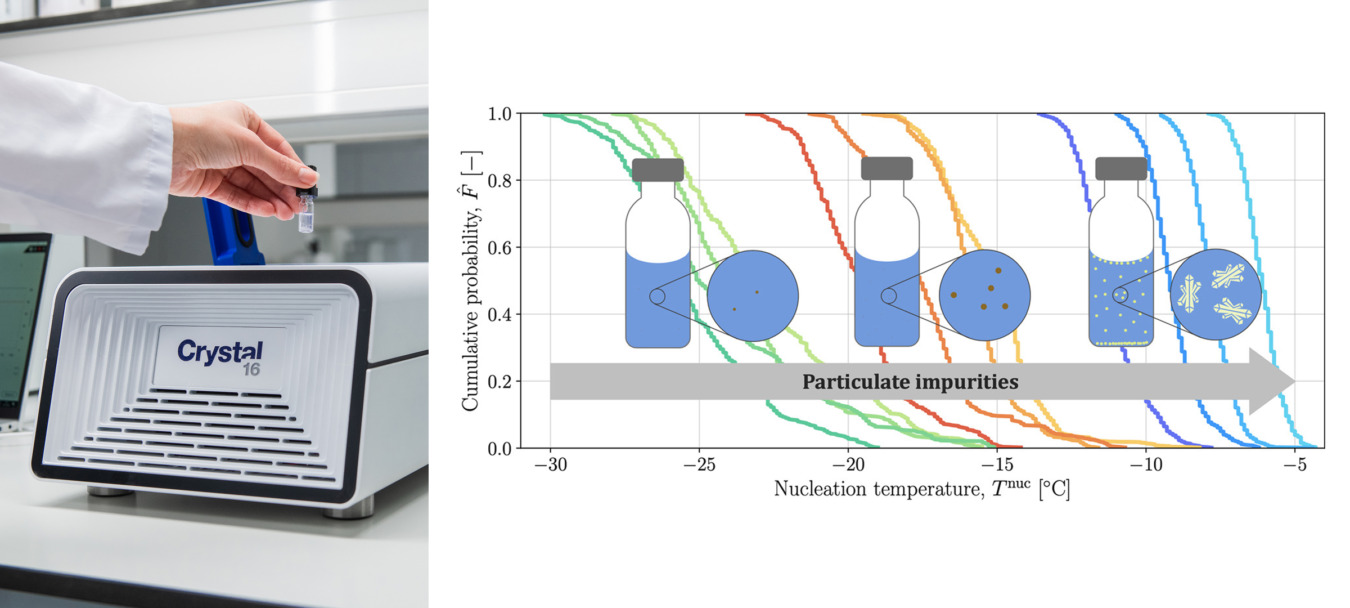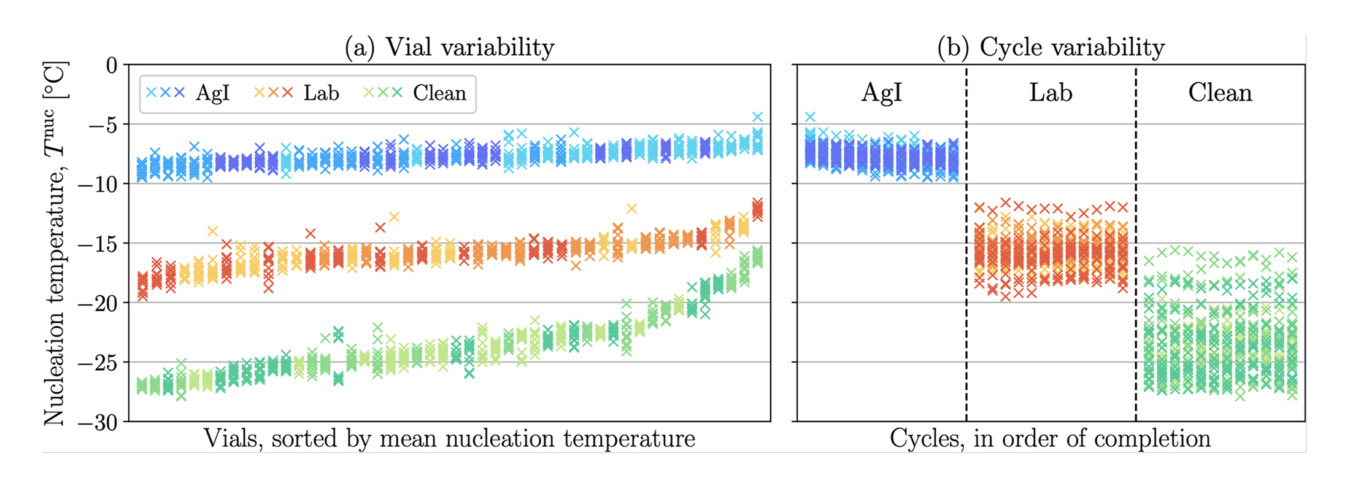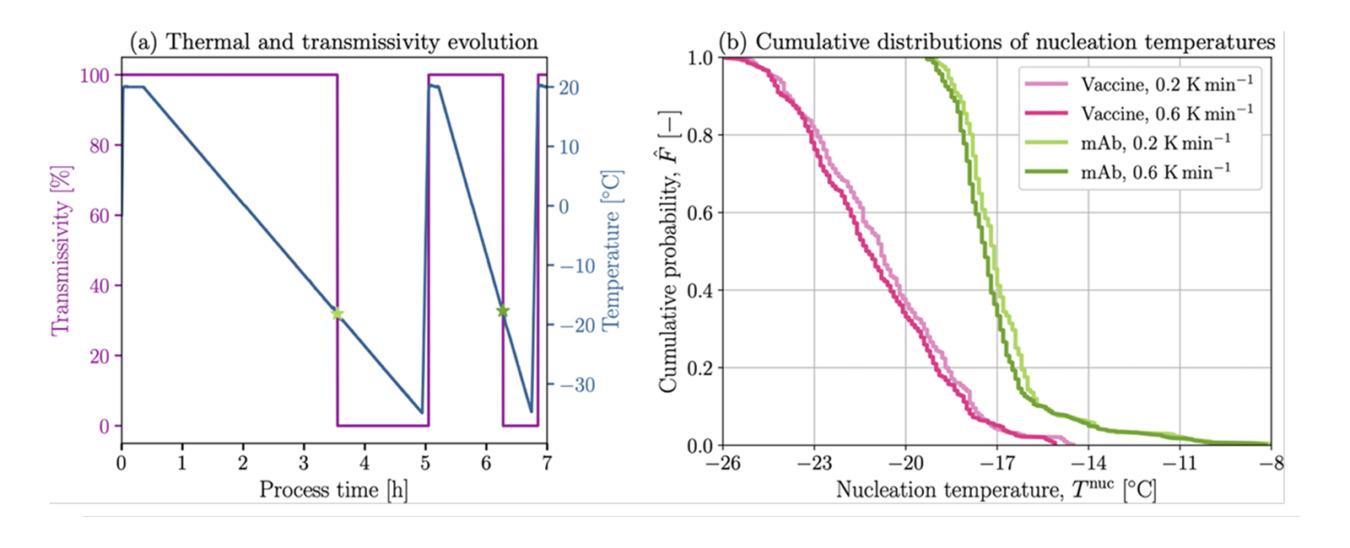Introduction
The nucleation of ice in biopharmaceutical vials significantly impacts freezing and freeze-drying processes.
We are excited to spotlight this study titled Quantifying the effect of particulate impurities on the ice nucleation behavior of pharmaceutical solutions, authored by a research team from the Institute of Energy and Process Engineering (ETH Zurich).
The study investigates how particulate impurities influence nucleation behavior, a critical factor in drug manufacturing. Using sucrose solutions, nucleation temperatures were measured under three conditions: standard lab preparation, particulate-free preparation, and samples spiked with silver iodide (AgI), a known nucleating agent. Nucleation variability among vials is shown to depend largely on particulate content rather than intrinsic stochasticity alone. These insights are vital for process design in the pharmaceutical industry.
Experimental Methods
Nucleation experiments were conducted using a customized Crystal16 instrument, allowing cooling down to −35 °C. Samples included sucrose solutions (10–40 wt%), prepared under three conditions: standard laboratory conditions, sterile particulate-free conditions at Janssen, or spiked with 50.0 ± 0.1 mg of silver iodide (AgI) to enhance nucleation. For each condition, three experiments were performed, each with 12 freeze–thaw cycles across 16 vials, totaling 576 nucleation events. Crystal16 automated the detection of nucleation via transmissivity, eliminating the need for invasive thermocouples and thus preserving particulate-free conditions. Additionally, the ice nucleation behavior of two Janssen drug products—a viral vector-based vaccine and a monoclonal antibody (mAb)—was evaluated under two cooling rates (0.6 and 0.2 K/min) using the same vials in alternating cycles.

Results & discussion
The nucleation temperatures showed clear dependence on particulate levels. Vials spiked with silver iodide (AgI) nucleated at the highest temperatures with minimal supercooling (~7 K) and showed highly uniform behavior, as shown in Figure 1, demonstrating that nucleants reduce variability.
Particulate-free samples required much deeper supercooling (~22 K) and had the widest spread in nucleation temperatures, with external variance over ten times that of AgI-spiked vials. This highlights the strong influence of particulates on nucleation rate and consistency.
Samples prepared under standard lab conditions showed intermediate behavior (~14 K supercooling), confirming the correlation between impurity level and nucleation behavior. Internal variance (within-vial, across cycles) remained low across all cases (0.2–0.4 K²), indicating that variability mainly arises between vials rather than from cycle-to-cycle randomness.

Figure 1: Nucleation temperatures for 20 wt% sucrose solutions under three conditions: AgI-spiked (blue), standard lab (orange), and particulate-free (green). (a) Sorted by vial mean; (b) sorted by freeze–thaw cycle.
For biopharmaceutical products, notable differences were observed. Despite longer commercial freezing timescales (e.g., days for the Janssen COVID-19 vaccine), nucleation behavior remained consistent across cycles, showing no dependence on sample history (Figure 2). The mAb had higher and more consistent nucleation temperatures than the vaccine, allowing freezing under milder conditions. Cooling rate had little effect on nucleation temperatures, indicating that even slow commercial freezing requires sufficiently low temperatures for reliable ice formation.

Figure 2: (a) Thermal profile showing sequential freezing of the same vials at 0.2 and 0.6 K/min with nucleation detected via transmissivity. (b) Nucleation temperatures for the vaccine (red) and mAb (green) at both cooling rates.
Conclusion
Particulate impurities are the primary driver of heterogeneity in ice nucleation across vials. Crystal16 proved to be a robust tool for quantifying nucleation kinetics under various conditions without compromising sample integrity. While AgI spiking reduces variability, such an approach is impractical for real pharmaceutical use. Therefore, improving vial surface properties may be more feasible strategies for controlling nucleation behavior in clean manufacturing environments.
References
We thank the authors for their valuable contributions and insights!
Leif-Thore Deck, Nikita Gusev, Vasiliki Deligianni, Marco Mazzotti: Quantifying the effect of particulate impurities on the ice nucleation behavior of pharmaceutical solutions, International Journal of Pharmaceutics, Volume 670, 2025, 125137, ISSN 0378-5173, https://doi.org/10.1016/j.ijpharm.2024.125137
See the Crystal16 in action
Can Crystal16 accelerate your pharmaceutical research? Let's run a demo – online or in your lab – to find out.